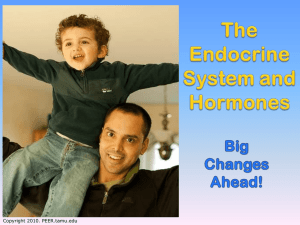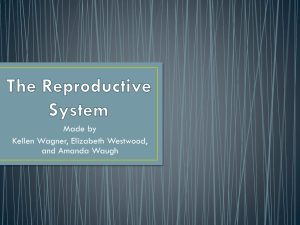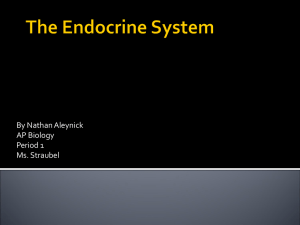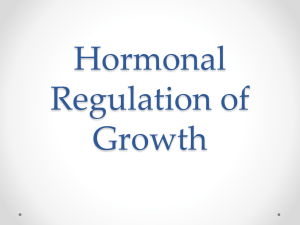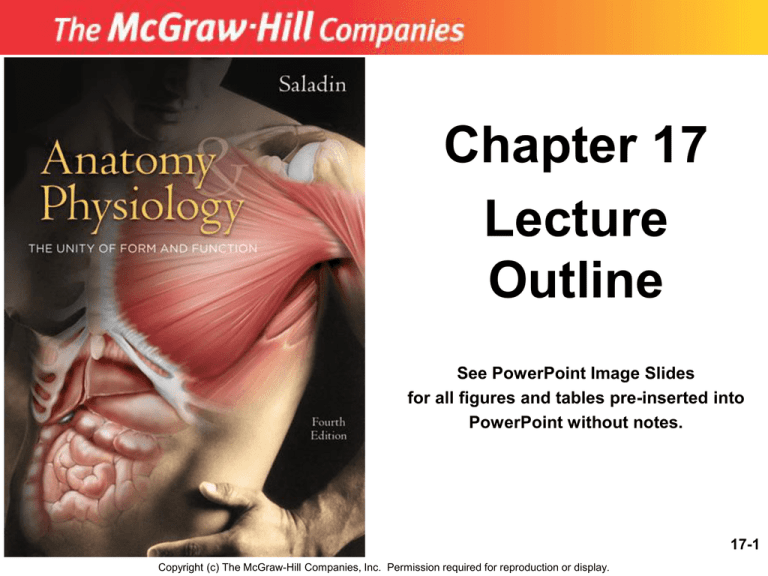
Chapter 17
Lecture
Outline
See PowerPoint Image Slides
for all figures and tables pre-inserted into
PowerPoint without notes.
17-1
Copyright (c) The McGraw-Hill Companies, Inc. Permission required for reproduction or display.
Endocrine System
•
•
•
•
•
•
•
Overview
Hypothalamus and pituitary gland
Other endocrine glands
Hormones and their actions
Stress and adaptation
Eicosanoids and paracrine signaling
Endocrine disorders
17-2
Overview of Cell Communications
• Necessary for integration of cell activities
• Mechanisms
– gap junctions
• pores in cell membrane allow signaling chemicals to move
from cell to cell
– neurotransmitters
• released from neurons to travel across gap to 2nd cell
– paracrine (local) hormones
• secreted into tissue fluids to affect nearby cells
– hormones (strict definition)
• chemical messengers that travel in the bloodstream
17-3
Endocrine System Components
• Hormone
– chemical messenger secreted
into bloodstream, stimulates
response in another tissue or
organ
• Target cells
– have receptors
for hormone
• Endocrine glands
– produce hormones
• Endocrine system
– endocrine organs (thyroid,
pineal, etc)
– hormone producing cells in
organs (brain, heart and small
intestine)
17-4
Endocrine Organs
• Major organs of endocrine system
17-5
Endocrine vs. Exocrine Glands
• Exocrine glands
– ducts carry secretion to a surface or organ
cavity
– extracellular effects (food digestion)
• Endocrine glands
– no ducts, release hormones into tissue fluids,
have dense capillary networks to distribute
hormones
– intracellular effects, alter target cell
metabolism
17-6
Nervous vs. Endocrine Systems
• Communication
– nervous - both electrical and chemical
– endocrine - only chemical
• Speed and persistence of response
– nervous - reacts quickly (1 - 10 msec), stops quickly
– endocrine - reacts slowly (hormone release in
seconds or days), effect may continue for weeks
• Adaptation to long-term stimuli
– nervous - response declines (adapts quickly)
– endocrine - response persists
• Area of effect
– nervous - targeted and specific (one organ)
– endocrine - general, widespread effects (many
organs)
17-7
Communication by the Nervous and
Endocrine Systems
17-8
Nervous and Endocrine Systems
• Several chemicals function as both hormones
and neurotransmitters
– NE, cholecystokinin, thyrotropin-releasing hormone,
dopamine and ADH
• Some hormones secreted by neuroendocrine
cells (neurons)
– oxytocin and catecholamines
• Both systems with overlapping effects on same
target cells
– NE and glucagon cause glycogen hydrolysis in liver
• Systems regulate each other
– neurons trigger hormone secretion
– hormones stimulate or inhibit neurons
17-9
Hypothalamus
• Shaped like a flattened funnel, forms floor
and walls of third ventricle
• Regulates primitive functions from water
balance to sex drive
• Many functions carried out by pituitary
gland
17-10
Pituitary Gland (Hypophysis)
• Suspended from hypothalamus by stalk
(infundibulum)
• Location and size
– housed in sella turcica of sphenoid bone
– 1.3 cm diameter
• Adenohypophysis (anterior pituitary)
– arises from hypophyseal pouch (outgrowth of
pharynx)
• Neurohypophysis
– arises from brain
17-11
Embryonic Development
17-12
Pituitary Gland Anatomy and
Hormones of Neurohypophysis
17-13
Hypothalamo-Hypophyseal Portal
System
• Hormones travel in portal system from
hypothalamus to anterior pituitary
• Hormones secreted by anterior pituitary
17-14
Histology of Pituitary Gland
17-15
Pituitary Hormones - Anterior Lobe
• Tropic hormones target other endocrine
glands
– gonadotropins target gonads
• FSH (follicle stimulating hormone)
• LH (luteinizing hormone)
– TSH (thyroid stimulating hormone)
– ACTH (adrenocorticotropic hormone)
• PRL (prolactin)
• GH (growth hormone)
17-16
Anterior Pituitary Hormones
• Principle hormones and target organs shown
• Axis - refers to way endocrine glands interact
17-17
Pituitary Hormones - Pars Intermedia
• Present in fetus; absent in adult
• Remnant cells
– produce POMC (pro-opiomelanocortin)
• processed into ACTH and endorphins
• Produces MSH in animals influencing
pigmentation of skin, hair or feathers
– not apparently present/functioning in
humans
17-18
Pituitary Hormones - Posterior Lobe
• OT (oxytocin) and ADH
– produced in hypothalamus
– transported by hypothalamo-hypophyseal
tract to posterior lobe (stores then releases
hormones)
17-19
Hormone Actions: Anterior Lobe
• FSH (secreted by gonadotrope cells)
– stimulates production of egg or sperm
cells
• LH (secreted by gonadotrope cells)
– mainly stimulates hormone production
• females - stimulates ovulation and corpus
luteum to secrete progesterone and estrogen
• males - stimulates interstitial cells of testes to
secrete testosterone
• TSH (secreted by thyrotropes)
– stimulates growth of gland and secretion of
TH
17-20
Hormone Actions: Anterior Lobe
• ACTH or corticotropin (secreted by
corticotropes)
– regulates response to stress, stimulates
adrenal cortex
• corticosteroids regulate glucose, fat and protein
metabolism
• PRL (secreted by lactotropes)
– female - milk synthesis after delivery
– male - LH sensitivity, thus testosterone
secretion
• GH or somatotropin – see next two slides
17-21
Growth Hormone
• Secreted by somatotropes of anterior pituitary
• Promotes tissue growth
– mitosis and cellular differentiation
– stimulates liver to produce IGF-I and II
• protein synthesis
– DNA transciption for mRNA production, proteins
synthesized
– enhances amino acid transport into cells, protein
catabolism
• lipid metabolism
– stimulates FFA and glycerol release from adipocytes, protein
sparing
• CHO metabolism
– glucose sparing effect = less glucose used for energy
• Electrolyte balance
– promotes Na+, K+, Cl- retention, Ca 2+ absorption
17-22
Growth Hormone and Aging
• Childhood and adolescence
– bone, cartilage and muscle growth
– Stimulates growth at epiphyseal plates
• Adulthood
– increase osteoblastic activity and appositional
growth affecting bone thickening and remodeling
– blood concentration decrease by age 75 to ¼ of that
of adolescent
• Levels of GH (fluctuates throughout day)
– higher during deep sleep, after high protein meals,
after vigorous exercise
– lower after high CHO meals
17-23
Hormone Actions: Posterior Lobe
• ADH
– targets kidneys
• water retention, reduce urine
– also functions as neurotransmitter
• Oxytocin
– labor contractions, lactation
– possible role in
• sperm transport
• emotional bonding
17-24
Control of Pituitary:
Hypothalamic and Cerebral Control
• Anterior lobe control - releasing hormones
and inhibiting hormones of hypothalamus
• Posterior lobe control - neuroendocrine
reflexes
– hormone release in response to nervous system
signals
• suckling infant stimulates nerve endings
hypothalamus posterior lobe oxytocin milk
ejection
– hormone release in response to higher brain
centers
• milk ejection reflex can be triggered by a baby's cry
17-25
Control of Pituitary:
Feedback from Target Organs
• Negative feedback
– target organ
hormone levels
inhibits release of
tropic hormones
Positive feedback
stretching of uterus
OT release, causes
more stretching of
uterus, until delivery
17-26
Pineal Gland
• Peak secretion ages 1-5; by puberty 75%
lower
• Produces serotonin by day, converts it to
melatonin at night
• May regulate timing of puberty in humans
• Melatonin in SAD + PMS; by
phototherapy
– depression, sleepiness, irritability and
carbohydrate craving
17-27
Thymus
• Location: mediastinum, superior to heart
• Involution after puberty
• Secretes hormones that regulate development
and later activation of T-lymphocytes
– thymopoietin and thymosins
17-28
Thyroid Gland Anatomy
Fig. 17.9a
• Largest endocrine gland; high rate of blood
flow
– arises root of embryonic tongue
• Anterior and lateral sides of trachea
– two large lobes connected by isthmus
17-29
Thyroid Gland
• Thyroid follicles
– filled with colloid and lined with simple cuboidal
epithelial (follicular cells) that secretes two
hormones, T3 and T4
– thyroid hormone
•
•
•
•
•
body’s metabolic rate and O2 consumption
calorigenic effect - heat production
heart rate and contraction strength
respiratory rate
stimulates appetite and breakdown CHO, lipids and
proteins
• C (calcitonin or parafollicular) cells
– produce calcitonin that blood Ca2+ , promotes
Ca2+ deposition and bone formation especially in
children
17-30
Histology of the Thyroid Gland
17-31
Parathyroid Glands
• PTH release
– blood Ca2+ levels
– promotes synthesis of
calcitriol
• absorption of Ca2+
• urinary excretion
• bone resorption
17-32
Adrenal Gland
17-33
Adrenal Medulla
• Sympathetic ganglion innervated by
sympathetic preganglionic fibers
– consists of modified neurons called chromaffin
cells
– stimulation causes release of catecholamines
(epinephrine, NE)
• Hormonal effect is longer lasting
– Increases alertness, anxiety, or fear
– increases BP, heart rate and air flow
– raises metabolic rate
• inhibits insulin secretion
• stimulates gluconeogenesis and glycogenolysis
• Stress causes medullary cells to stimulate
cortex
17-34
Adrenal Cortex
• Layers
– zona glomerulosa (outer)
– zona fasciculata (middle)
– zona reticularis (inner)
17-35
Adrenal Cortex
• Corticosteroids
– mineralocorticoids (zona glomerulosa)
• control electrolyte balance, aldosterone promotes Na+
retention and K+ excretion
– glucocorticoids (zona fasciculata)
• especially cortisol, stimulates fat and protein catabolism,
gluconeogenesis (from a.a.’s and FA’s) and release of
fatty acids and glucose into blood
• anti-inflammatory effect becomes immune suppression
with long-term use
– sex steroids (zona reticularis)
• androgen (including DHEA which other tissues convert to
testosterone) and estrogen (important after menopause)
17-36
Pancreas
• Retroperitoneal, inferior and dorsal to stomach
17-37
Pancreatic Hormones
• 1-2 million islets produce hormones
– 98% of organ produces digestive enzymes
(exocrine)
• Insulin (from cells)
– secreted after meal with carbohydrates raises
glucose blood levels
– stimulates glucose and amino acid uptake
– nutrient storage effect (stimulates glycogen,
fat and protein synthesis)
– antagonizes glucagon
17-38
Pancreatic Hormones
• Glucagon (from cells)
– secreted in very low carbohydrate and high
protein diet or fasting
– stimulates glycogenolysis, fat catabolism
(release of FFA’s) and promotes absorption
of amino acids for gluconeogenesis
• Somatostatin (from delta () cells)
– secreted with rise in blood glucose and
amino acids after a meal
– paracrine secretion = inhibits secretion of
insulin, glucagon by and cells
17-39
Pancreatic Hormones
• Hyperglycemic hormones raise blood
glucose
– GH, epinephrine, NE, cortisol and
corticosterone
• Hypoglycemic hormones lower blood
glucose
– insulin
17-40
Histology of Ovary
Follicles = egg surrounded by granulosa cells
17-41
Ovary
• Granulosa cells in wall of ovarian follicle
– produces estradiol, first half of menstrual cycle
• Corpus luteum: follicle after ovulation
– produces estradiol and progesterone for 12 days or 812 weeks with pregnancy
• Functions of estradiol and progesterone
– development of female reproductive system and
physique including bone growth
– regulate menstrual cycle, sustain pregnancy
– prepare mammary glands for lactation
• Both secrete inhibin: suppresses FSH secretion
17-42
Testes
• Interstitial cells (between seminiferous
tubules)
– produce testosterone and estrogen
• Functions
– development of male reproductive system and
physique
– sustains sperm production and sex drive
• Sustentacular sertoli cells
– secrete inhibin which suppresses FSH
secretion which stabilizes sperm production
rates
17-43
Endocrine Functions of Other Organs
• Heart –
– atrial natriuretic peptide released with an increase in
BP
– blood volume and BP by Na+ and H2O loss by
kidneys
• Skin - helps produce D3
• Liver
– 15% of erythropoietin (stimulates bone marrow)
– angiotensinogen (a prohormone)
• precursor of angiotensin II
– source of IGF-I (works with GH)
– converts vitamin D3 to calcidiol
– Hepcidin – promotes intestinal absorption of iron
17-44
Endocrine Functions of Other Organs
• Kidneys
– produces 85% of erythropoietin –
• stimulates bone marrow to produce RBC’s
– convert angiotensinogen to angiotensin I
– converts calcidiol to calcitriol (active form of vitamin D)
• absorption by intestine and inhibits loss in the urine
• more Ca2+ available for bone deposition
• Stomach and small intestines (10 enteric
hormones)
– coordinate digestive motility and secretion
• Placenta
– secretes estrogen, progesterone and others
• regulate pregnancy, stimulate development of fetus and
mammary glands
17-45
Hormone Chemistry
• Steroids
– derived from cholesterol
– sex steroids,
corticosteroids
• Peptides and
glycoproteins
– OT, ADH; all releasing
and inhibiting hormones
of hypothalamus; most
of anterior pituitary
hormones
• Monoamines (biogenic
amines)
– derived from amino
acids
• catecholamines
(norepinephrine,
epinephrine, dopamine)
and thyroid hormones
17-46
Oxytocin and ADH
17-47
Hormone Synthesis: Steroid Hormones
• Synthesized from cholesterol – differs in functional
groups attached to 4-ringed steroid backbone
17-48
Hormone Synthesis: Peptides
• Cellular steps
– RER removes
segment, forms
prohormone
– Golgi complex
further modifies it
into hormone
– e.g. insulin formation
• preproinsulin
converted to
proinsulin in RER
• proinsulin split into
insulin and C peptide
in golgi complex
17-49
Hormone Synthesis: Monoamines
• All are synthesized from tyrosine
– except melatonin which is synthesized from
tryptophan
• Thyroid hormone is unusual
– composed of two tyrosine molecules
– requires a mineral, iodine
17-50
Thyroid Hormone Synthesis
Fig. 17.18
17-51
T3 and T4 Synthesis
• Follicular cells
– absorb I- from blood and store in lumen as I– synthesize thyroglobulin and store in lumen
• contains tyrosine
– tyrosine and Iodine form T3 and T4
• TSH
– stimulates follicular cells to remove T3 and
T4 from thyroglobulin for release into
plasma
17-52
Chemistry of Thyroid Hormone
Fig. 17.19
MIT contains one iodine atom, DIT has two
T3 = combination of MIT plus DIT
T4 = combination of two DITs
17-53
Hormone Transport
• Monoamines and peptides are hydrophilic
– mix easily with blood plasma
• Steroids and thyroid hormone are hydrophobic
– must bind to transport proteins for transport
– bound hormone - attached to transport protein,
• prolongs half-life to weeks
• protects from enzymes and kidney filtration
– unbound hormone leaves capillary to reach target
cell (half-life a few minutes)
• Transport proteins in blood plasma
– albumin, thyretin and TGB (thyroxine binding
globulin) bind to thyroid hormone
– steroid hormones bind to globulins (transcortin)
– aldosterone - no transport protein, 20 min. half-life
17-54
Hormone Receptors
• Located on plasma membrane,
mitochondria, other organelles, or in
nucleus
• Usually thousands for given hormone
– hormone binding turns metabolic
pathways on or off
• Exhibit specificity and saturation
17-55
Hormone Mode of Action
• Hydrophobic
hormones
– penetrate
plasma
membrane –
enter nucleus
• Hydrophilic
hormones
– must bind to
cell-surface
receptors
17-56
Thyroid Hormone Effects
• TH binds to
receptors on
– mitochondria
• rate of
aerobic
respiration
– ribosomes and
chromatin
• protein
synthesis
• Na+-K+ ATPase
produced
– generates heat
17-57
Hydrophilic Hormones: Mode of Action
cAMP as Second Messenger
1) Hormone binding
activates G protein
2) Activates adenylate
cyclase
3) Produces cAMP
4) Activates kinases
5) Activates enzymes
6) Metabolic reactions:
– synthesis
– secretion
– change membrane
potentials
17-58
Hydrophilic Hormones: Mode of Action
Other 2nd and 3rd Messengers
Hormones may use different second messengers in different
tissues.
17-59
Enzyme Amplification
17-60
Hormone Clearance
•
•
•
•
•
Hormone signals must be turned off
Take up and degraded by liver and kidney
Excreted in bile or urine
Metabolic clearance rate (MCR)
Half-life - time required to clear 50% of
hormone
17-61
Modulation of Target Cell Sensitivity
• Long-term use of high pharmacological doses
– bind to receptor sites of related hormones
– target cell may convert to different hormone
17-62
Hormone Interactions
• Most cells sensitive to more than one
hormone and exhibit interactive effects
• Synergistic effects
• Permissive effects
– one hormone enhances response to a
second hormone
• Antagonistic effects
17-63
Stress and Adaptation
•
Stress
– caused by any situation that upsets
homeostasis and threatens one’s physical
or emotional well-being
•
General adaptation syndrome
– way body reacts to stress
– occurs in 3 stages
1. alarm reaction
2. stage of resistance
3. stage of exhaustion
17-64
Alarm Reaction
•
•
•
•
•
Initial response
epinephrine and norepinephrine levels
HR and BP
blood glucose levels
Sodium and water retention
(aldosterone)
17-65
Stage of Resistance
• After a few hours, glycogen reserves
gone
• ACTH and cortisol levels
• Fat and protein breakdown
• Gluconeogenesis
• Depressed immune function
• Susceptibility to infection and ulcers
17-66
Stage of Exhaustion
• Stress that continues until fat reserves are
gone
• Protein breakdown and muscle wasting
• Loss of glucose homeostasis
• Hypertension and electrolyte imbalances
(loss of K+ and H+)
• Hypokalemia and alkalosis leads to death
17-67
Paracrine Secretions
• Chemical messengers that diffuse short
distances and stimulate nearby cells
– unlike neurotransmitters not produced in neurons
– unlike hormones not transported in blood
• Examples and their functions
– histamine
• from mast cells in connective tissue
• causes relaxation of blood vessel smooth muscle
– nitric oxide
• from endothelium of blood vessels, causes vasodilation
– somatostatin
• from gamma cells, inhibits secretion of alpha and beta cells
– catecholamines
• diffuse from adrenal medulla to cortex
17-68
Eicosanoids: a Paracrine Secretion
• Leukotrienes
– converted from arachidonic acid (by lipoxygenase)
– mediates allergic and inflammatory reactions
• Prostacyclin (by cyclooxygenase)
– inhibits blood clotting and vasoconstriction
• Thromboxanes (by cyclooxygenase)
– produced by blood platelets after injury; override
prostacyclin, stimulates vasoconstriction and clotting
• Prostaglandins (by cyclooxygenase): diverse; includes
– PGE: relaxes smooth muscle in bladder, intestines,
bronchioles, uterus and stimulates contraction of blood
vessels
– PGF: opposite effects
17-69
Eicosanoid Synthesis
17-70
Endocrine Disorders
• Variations in hormone concentration and target
cell sensitivity have noticeable effects on body
• Hyposecretion – inadequate hormone release
– tumor or lesion destroys gland
• head trauma affects pituitary gland’s ability to secrete ADH
– diabetes insipidus = chronic polyuria
• Hypersecretion – excessive hormone release
– tumors or autoimmune disorder
• toxic goiter (graves disease) – antibodies mimic effect of TSH
on the thyroid
17-71
Pituitary Disorders
• Hypersecretion of growth hormones
– acromegaly
– thickening of the bones and soft tissues
– problems in childhood or adolescence
• gigantism if oversecretion
• dwarfism if hyposecretion
17-72
Thyroid Gland Disorders
• Congenital hypothyroidism ( TH)
– infant suffers abnormal bone development,
thickened facial features, low temperature,
lethargy, brain damage
• Myxedema (adult hypothyroidism, TH)
– low metabolic rate, sluggishness, sleepiness,
weight gain, constipation, dry skin and hair, cold
sensitivity, blood pressure and tissue swelling
• Endemic goiter (goiter = enlarged thyroid
gland)
– dietary iodine deficiency, no TH, no - feedback,
TSH
• Toxic goiter (Graves disease)
– antibodies mimic TSH, TH, exophthalmos
17-73
Parathyroid Disorders
• Hypoparathyroid
– surgical excision during thyroid surgery
– fatal tetany 3-4 days
• Hyperparathyroid = excess PTH secretion
– tumor in gland
– causes soft, fragile and deformed bones
– blood Ca2+
– renal calculi
17-74
Adrenal Disorders
• Cushing syndrome - excess cortical secretion
– hyperglycemia, hypertension, weakness, edema
– muscle and bone loss occurs with protein catabolism
– buffalo hump and moon face = fat
deposition between shoulders or in face
• Adrenogenital syndrome (AGS)
– adrenal androgen hypersecretion; accompanies
Cushing
– enlargement of external sexual organs in children and
early onset of puberty
– masculinizing effects on women (deeper voice and
beard growth)
17-75
Diabetes Mellitus
• Signs and symptoms of hyposecretion of
insulin
– polyuria, polydipsia, polyphagia
– hyperglycemia, glycosuria, ketonuria
– osmotic diuresis
• blood glucose levels rise above transport
maximum of kidney tubules, glucose remains in
urine (ketones also present)
• increased osmolarity draws water into urine
17-76
Types of Diabetes Mellitus
• Type I (IDDM) - 10% of cases
– some cases have autoimmune destruction of
cells, diagnosed about age 12
– treated with diet, exercise, monitoring of blood
glucose and periodic injections of insulin
• Type II (NIDDM) - 90%
– insulin resistance
• failure of target cells to respond to insulin
– 3 major risk factors are heredity, age (40+) and
obesity
– treated with weight loss program of diet and
exercise
– oral medications improve insulin secretion or
target cell sensitivity
17-77
Pathology of Diabetes
• Acute pathology: cells cannot absorb glucose,
rely on fat and proteins (weight loss,
weakness)
– fat catabolism FFA’s in blood and ketone bodies
– ketonuria promotes osmotic diuresis, loss of Na+
and K+
– ketoacidosis occurs as ketones blood pH
• if continued causes dyspnea and eventually diabetic coma
• Chronic pathology
– chronic hyperglycemia leads to neuropathy and
cardiovascular damage from atherosclerosis
• retina and kidneys (common in type I), atherosclerosis
leads to heart failure (common in type II), and gangrene
17-78
Hyperinsulinism
• From excess insulin injection or
pancreatic islet tumor
• Causes hypoglycemia, weakness and
hunger
– triggers secretion of epinephrine, GH and
glucagon
• side effects: anxiety, sweating and HR
• Insulin shock
– uncorrected hyperinsulinism with
disorientation, convulsions or
unconsciousness
17-79





